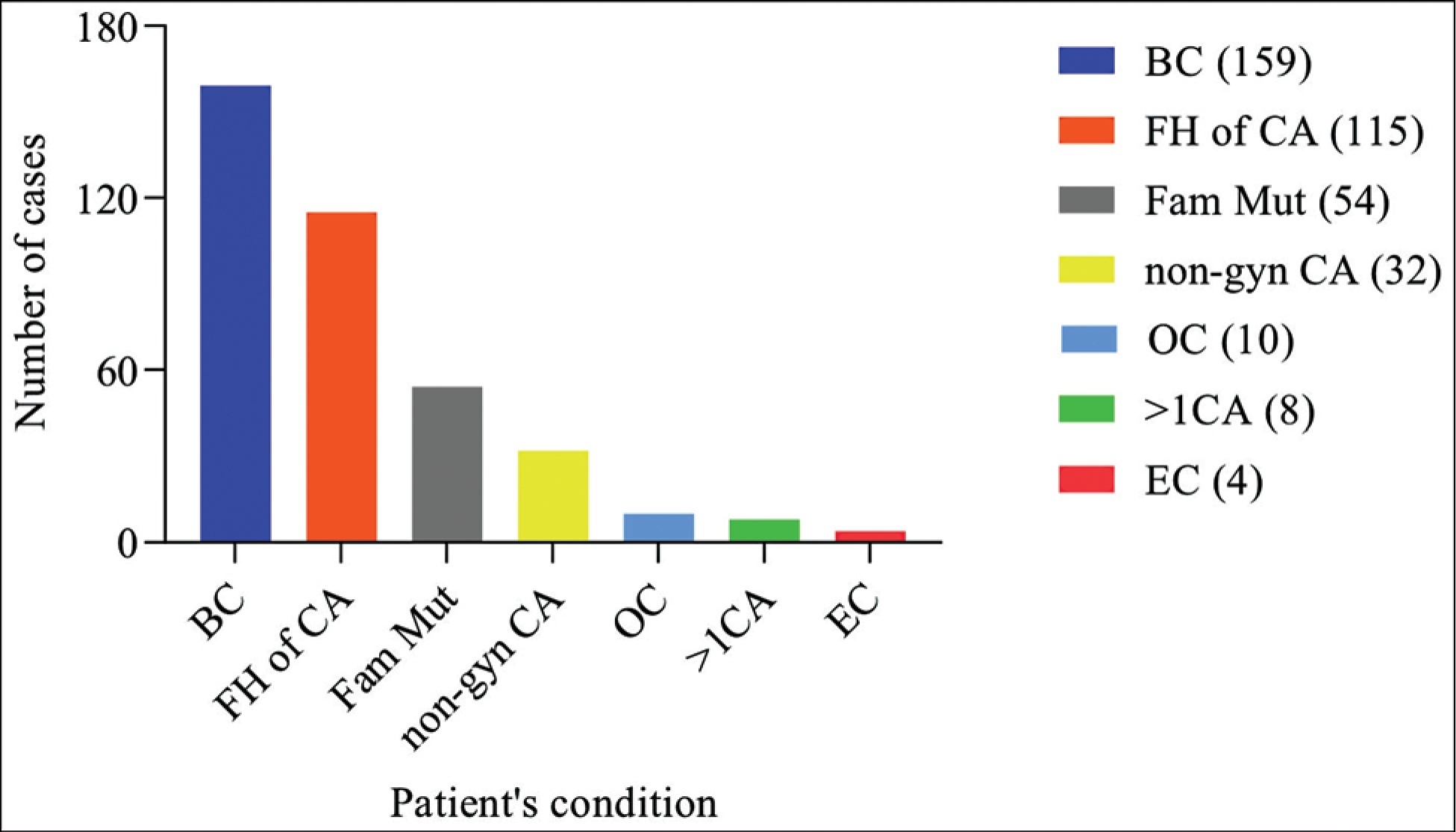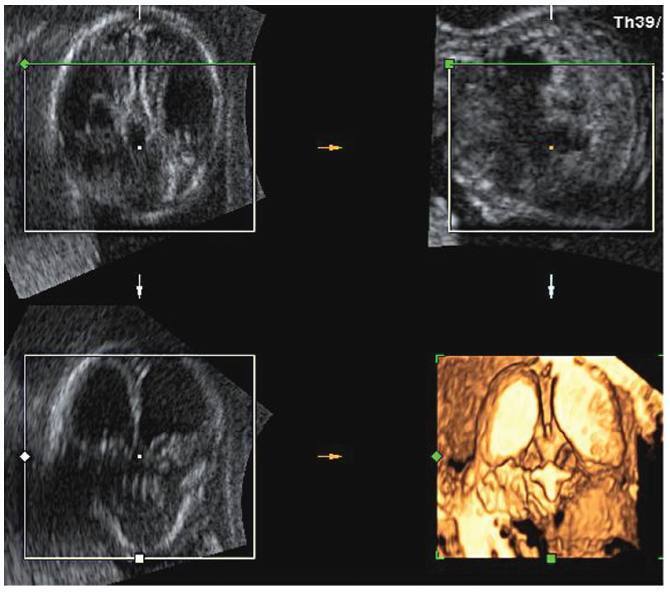-
Original Article
Germline Mutations Landscape in a Cohort of the State of Minas Gerais, Brazil, in Patients Who Underwent Genetic Counseling for Gynecological and Breast Cancer
Revista Brasileira de Ginecologia e Obstetrícia. 2023;45(2):074-081
07-10-2023
Summary
Original ArticleGermline Mutations Landscape in a Cohort of the State of Minas Gerais, Brazil, in Patients Who Underwent Genetic Counseling for Gynecological and Breast Cancer
Revista Brasileira de Ginecologia e Obstetrícia. 2023;45(2):074-081
07-10-2023Views103See moreAbstract
Objective
The present study evaluated the profile of germline mutations present in patients who underwent genetic counseling for risk assessment for breast cancer (BC), ovarian cancer (OC), and endometrial cancer (EC) with a possible hereditary pattern.
Methods
Medical records of 382 patients who underwent genetic counseling after signing an informed consent form were analyzed. A total of 55.76% of patients (213/382) were symptomatic (personal history of cancer), and 44.24% (169/382) were asymptomatic (absence of the disease). The variables analyzed were age, sex, place of birth, personal or family history of BC, OC, EC, as well as other types of cancer associated with hereditary syndromes. The Human Genome Variation Society (HGVS) nomenclature guidelines were used to name the variants, and their biological significance was determined by comparing 11 databases.
Results
We identified 53 distinct mutations: 29 pathogenic variants, 13 variants of undetermined significance (VUS), and 11 benign. The most frequent mutations were BRCA1 c.470_471delCT, BRCA1 c.4675 + 1G > T, and BRCA2 c.2T> G. Furthermore, 21 variants appear to have been described for the first time in Brazil. In addition to BRCA1/2 mutations, variants in other genes related to hereditary syndromes that predispose to gynecological cancers were found.
Conclusion
This study allowed a deeper understanding of the main mutations identified in families in the state of Minas Gerais and demonstrates the need to assess the family history of non-gynecological cancer for risk assessment of BC, OC, and EC. Moreover, it is an effort that contributes to population studies to evaluate the cancer risk mutation profile in Brazil.

-
Original Article
Histological and Immunohistochemical Characteristics for Hereditary Breast Cancer Risk in a Cohort of Brazilian Women
Revista Brasileira de Ginecologia e Obstetrícia. 2022;44(8):761-770
04-25-2022
Summary
Original ArticleHistological and Immunohistochemical Characteristics for Hereditary Breast Cancer Risk in a Cohort of Brazilian Women
Revista Brasileira de Ginecologia e Obstetrícia. 2022;44(8):761-770
04-25-2022Views182Abstract
Objective
The study aimed to characterize the clinical, histological, and immunohistochemical profile of women with invasive breast cancer, according to the risk for Hereditary Predisposition Breast and Ovarian Cancer Syndrome in a Brazilian population.
Methods
This is a retrospective study performed from a hospital-based cohort of 522 women, diagnosed with breast cancer treated at an oncology referral center in the Southeast region of Brazil, between 2014 and 2016.
Results
Among the 430 women diagnosed with invasive breast cancer who composed the study population, 127 (29.5%) were classified as at increased risk for hereditary predisposition to breast and ovarian cancer syndrome. There was a lower level of education in patients at increased risk (34.6%) when compared with those at usual risk (46.0%). Regarding tumor characteristics, women at increased risk had higher percentages of the disease diagnosed at an advanced stage (32.3%), and with tumors > 2cm (63.0%), with increased prevalence for both characteristics, when compared with those at usual risk. Furthermore, we found higher percentages of HG3 (43.3%) and Ki-67 ≥ 25% (64.6%) in women at increased risk, with prevalence being about twice as high in this group. The presence of triple-negative tumors was observed as 25.2% in women at increased risk and 6.0% in women at usual risk, with the prevalence of absence of biomarkers being 2.5 times higher among women in the increased risk group.
Conclusion
From the clinical criteria routinely used in the diagnosis of breast cancer, the care practice of genetic counseling for patients at increased risk of hereditary breast cancer in contexts such as Brazil is still scarce.
Key-words Breast cancerCohort studiesGenetic counselinghereditary breast and ovarian cancer syndromeImmunohistochemistrySee more -
Case Reports
Prenatal Diagnosis of Lissencephaly Type 2 using Three-dimensional Ultrasound and Fetal MRI: Case Report and Review of the Literature
Revista Brasileira de Ginecologia e Obstetrícia. 2016;38(4):201-206
04-01-2016
Summary
Case ReportsPrenatal Diagnosis of Lissencephaly Type 2 using Three-dimensional Ultrasound and Fetal MRI: Case Report and Review of the Literature
Revista Brasileira de Ginecologia e Obstetrícia. 2016;38(4):201-206
04-01-2016Views135Abstract
Lissencephaly is a genetic heterogeneous autosomal recessive disorder characterized by the classical triad: brain malformations, eye anomalies, and congenital muscular dystrophy. Prenatal diagnosis is feasible by demonstrating abnormal development of sulci and gyri. Magnetic resonance imaging (MRI) may enhance detection of developmental cortical disorders as well as ocular anomalies. We describe a case of early diagnosis of lissencephaly type 2 detected at the time of routine second trimester scan by three-dimensional ultrasound and fetal MRI. Gross pathology confirmed the accuracy of the prenatal diagnosis while histology showed the typical feature of cobblestone cortex. As the disease is associated with poor perinatal prognosis, early and accurate prenatal diagnosis is important for genetic counseling and antenatal care.
Key-words cobblestone cortexGenetic counselinglissencephalyMagnetic resonance ImagingPathologyprenatal diagnosisthree-dimensional ultrasoundSee more
-
Artigos Originais
Chromosomal abnormalities in couples with history of recurrent abortion
Revista Brasileira de Ginecologia e Obstetrícia. 2009;31(2):68-74
04-22-2009
Summary
Artigos OriginaisChromosomal abnormalities in couples with history of recurrent abortion
Revista Brasileira de Ginecologia e Obstetrícia. 2009;31(2):68-74
04-22-2009DOI 10.1590/S0100-72032009000200004
Views98PURPOSE: to asses the prevalence and clinical characteristics of couples with history of recurrent spontaneous abortion and chromosome abnormality, attended at the present service. METHODS: all the couples referred to our service due to history of recurrent spontaneous abortion, from January 1975 to June 2008, were evaluated. Only the ones whose chromosome karyotype analysis by GTG bands has been successfully made were included in the study. Clinical data on their age, as well as on the number of abortions, stillbirth, multiple malformations, livebirth per couple, and the result of the karyotype exam were collected. Fisher's exact test (p<0.05) has been used to compare the incidence of chromosome alterations found in our study, with data in the literature. RESULTS: there were 108 couples in the sample. Their ages varied from 21 to 58 years old among the men (average of 31.4 years old), and from 19 to 43 among the women (average of 29.9 years old). In ten couples, one of the mates (9.3%) presented chromosome alterations, which corresponded respectively to three cases (30%) of reciprocal translocation [two of t(5;6) and one of t(2;13)], two (20%) of Robertsonian translocation [two of der(13;14) and one of der(13;15)], five(50%) of mosaicism (mos) [two cases of mos 45,X/46,XX, one of mos 46,XX/47,XXX, one of mos 46,XY/47,XXY and one of mos 46,XY/47,XYY] and one (10%) of chromosome inversion [inv(10)]. In one of the couples, the female presented two concomitant alterations: t(2;13) and der(13;14). Chromosome abnormalities were found in 5% of the couples with a history of two abortions, in 10.3% with three abortions, and in 14.3% with four or more abortions. CONCLUSIONS: the incidence of chromosome abnormalities seen in our study (9.3%) was similar to most of the studies carried out in the last 20 years, varying from 4.8 to 10.8%. Nevertheless the high percentage of patients with mosaicism in our sample, has called our attention. It is believed that this fact may be associated to the high number of metaphases ordinarily analyzed in the present service.
Key-words Abortion, habitualChromosome aberrationsCytogenetic analysisGenetic counselingKaryotypingMosaicismTranslocation, geneticSee more


